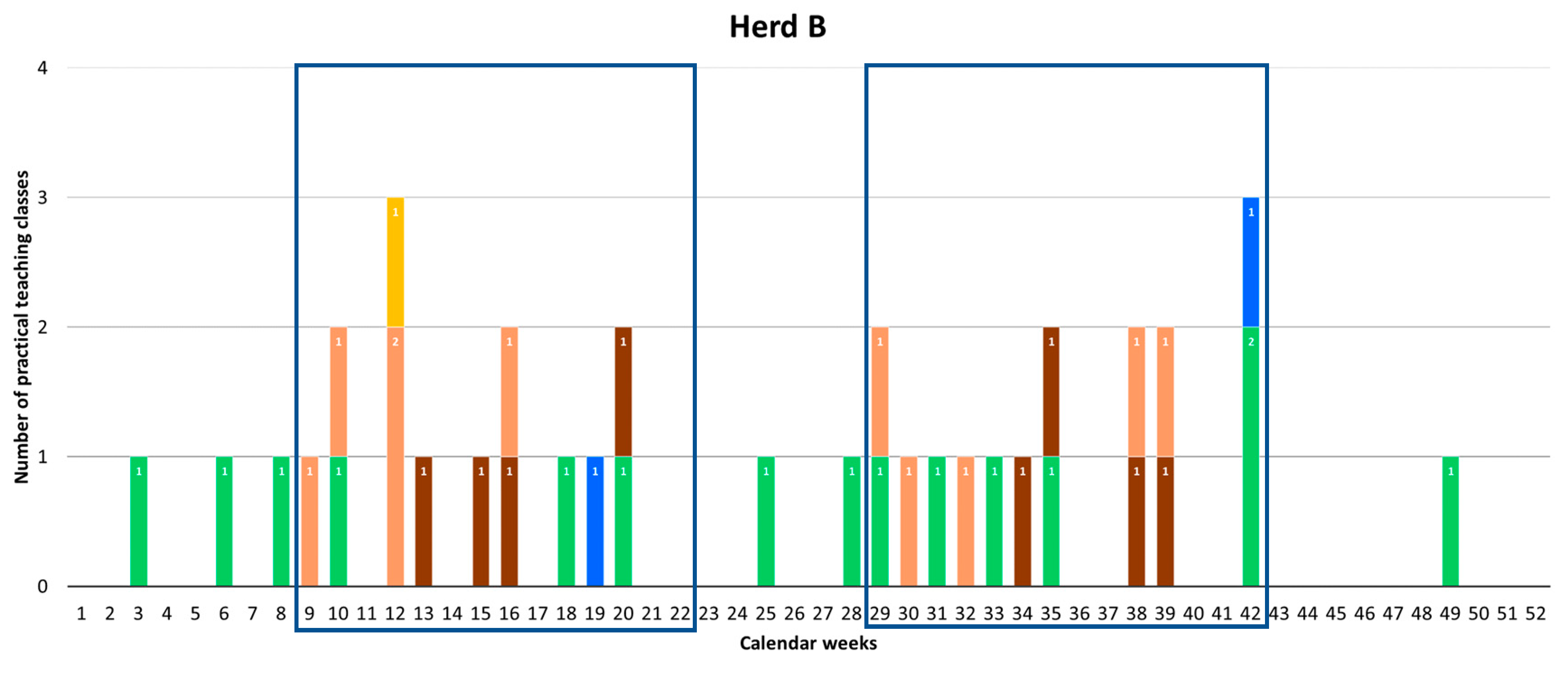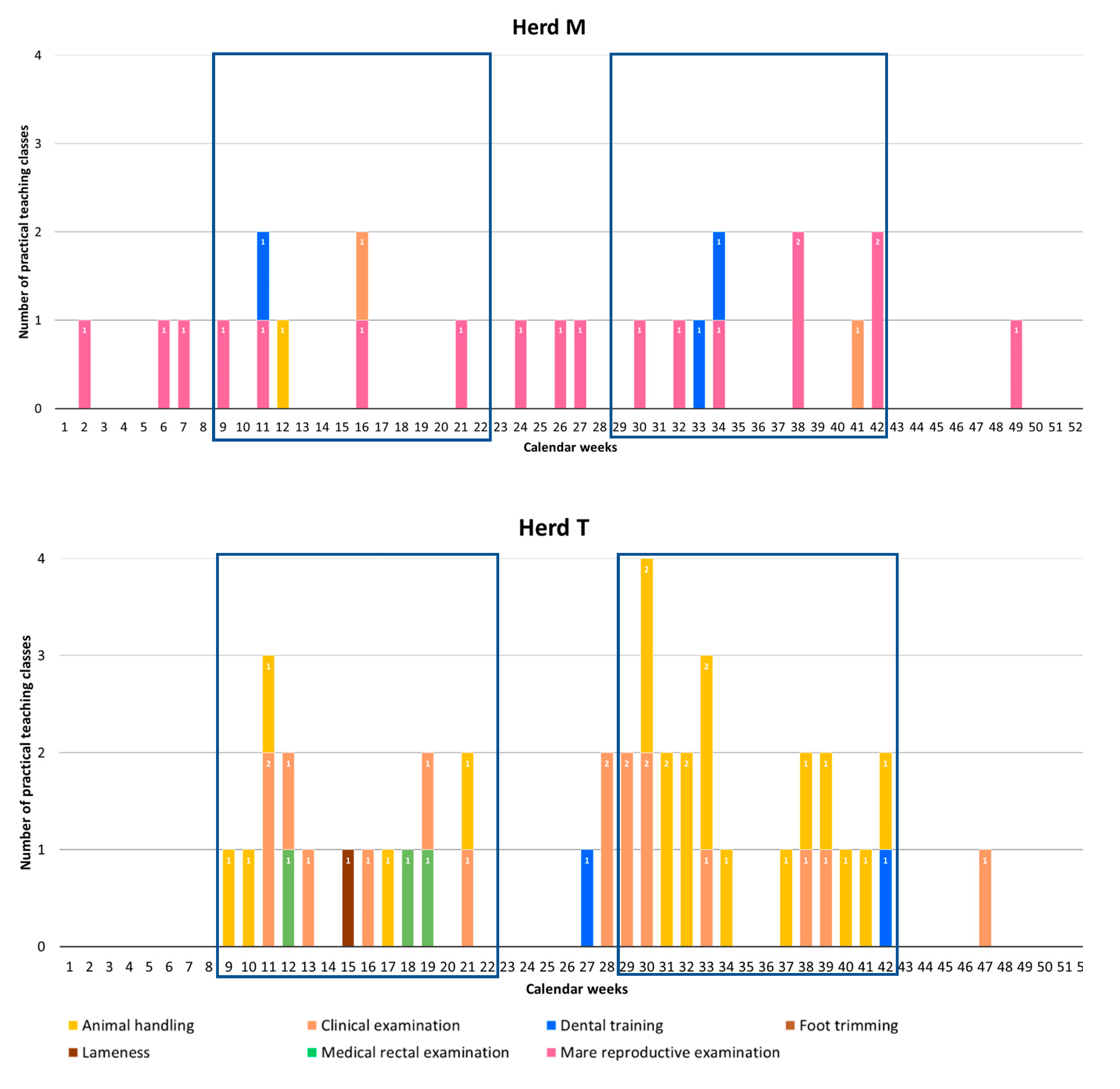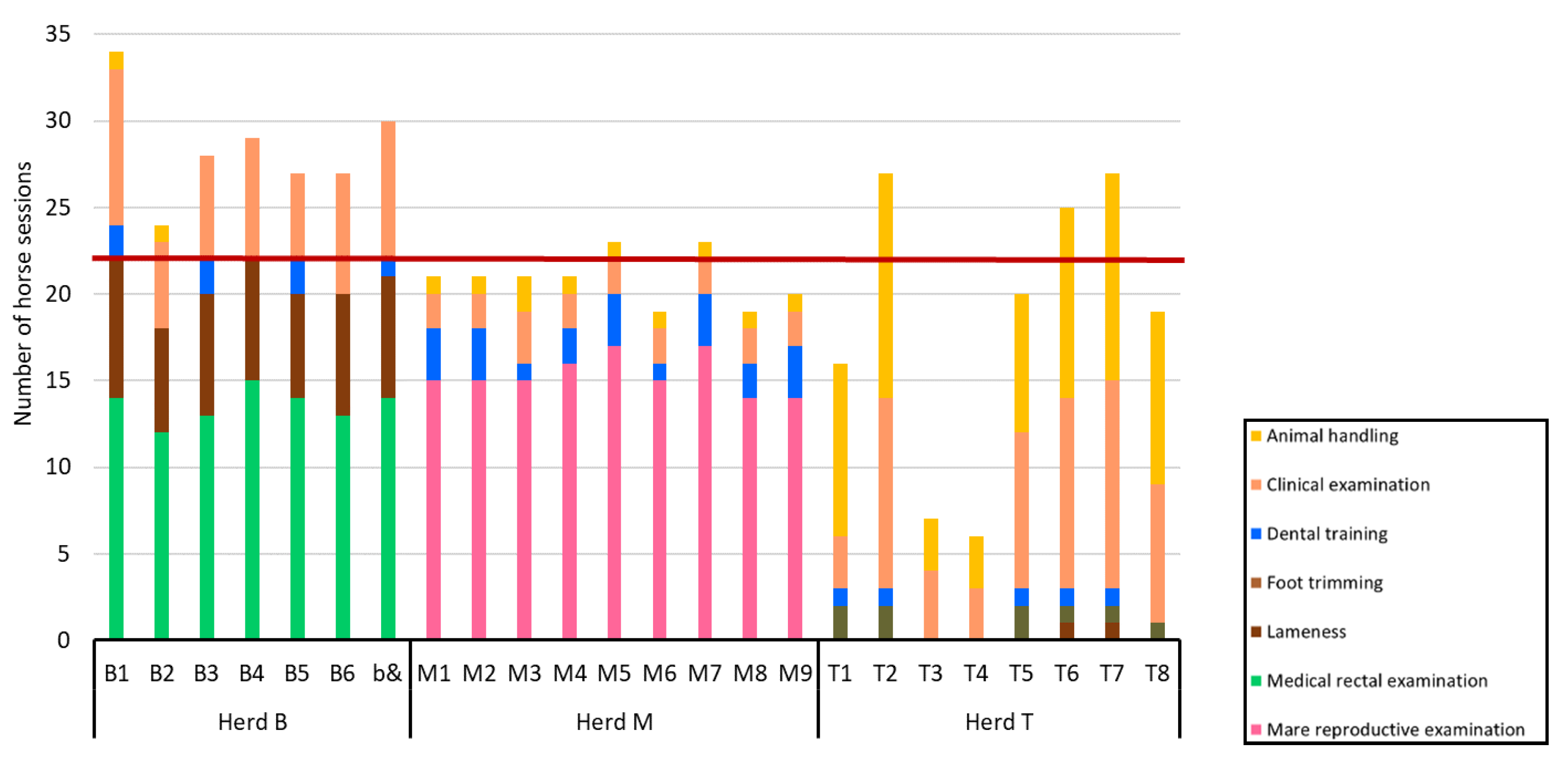Horses Used for Educational Purposes in New Zealand: A Descriptive Analysis of Their Use for Teaching
Simple Summary
Abstract
1. Introduction
2. Materials and Methods
Statistical Analysis
3. Results
3.1. General Activity
3.2. Teaching Activity
3.3. Main Practical Teaching Classes
4. Discussion
5. Conclusions
Author Contributions
Funding
Conflicts of Interest
References
- Hanlon, A.; Gath, V.; Mulligan, F. Practical animal-handling classes at University College Dublin. J. Vet. Med. Educ. 2007, 34, 561–565. [Google Scholar] [CrossRef] [PubMed]
- McGreevy, P.D. Firm but gentle: Learning to handle with care. J. Vet. Med. Educ. 2007, 34, 539–541. [Google Scholar] [CrossRef] [PubMed]
- Doherty, O.; McGreevy, P.D.; Pearson, G. The importance of learning theory and equitation science to the veterinarian. Appl. Anim. Behav. Sci. 2017, 190, 111–122. [Google Scholar] [CrossRef]
- Jaeggin, S.; Fürst, A.; Hässig, M.; Auer, J.A. Kick injuries of veterinarians during examination and treatment of horses: A retrospective study in Switzerland. Schweiz. Arch. Tierheilkd. 2005, 147, 289–295. [Google Scholar]
- Riley, C.B.; Liddiard, J.R.; Thompson, K. A cross-sectional study of horse-related injuries in veterinary and animal science students at an Australian university. Animals 2015, 5, 951–964. [Google Scholar] [CrossRef] [PubMed]
- Hawson, L.A.; McLean, A.N.; McGreevy, P.D. The roles of equine ethology and applied learning theory in horse-related human injuries. J. Vet. Behav. Clin. Appl. Res. 2010, 5, 324–338. [Google Scholar] [CrossRef]
- Coleman, G.T.; Hemsworth, P.H. Training to improve stockperson beliefs and behaviour towards livestock enhances welfare and productivity. Sci. Tech. Rev. Off. Int. Epizoot. 2014, 33, 131–137. [Google Scholar] [CrossRef]
- Mayberry, J.C.; Pearson, T.E.; Wiger, K.J.; Diggs, B.S.; Mullins, R.J. Equestrian Injury Prevention Efforts Need More Attention to Novice Riders. J. Trauma Acute Care Surg. 2007, 62, 735–739. [Google Scholar] [CrossRef]
- Ostovic, M.; Mikus, T.; Pavicic, Z.; Matkovic, K.; Mesic, Z. Influence of socio-demographic and experiential factors on the attitudes of Croatian veterinary students towards farm animal welfare. Vet. Med. 2017, 62, 417–428. [Google Scholar] [CrossRef]
- Wake, A.A.; Stafford, K.J.; Minot, E.O. The experience of dog bites: A survey of veterinary science and veterinary nursing students. N. Z. Vet. J. 2006, 54, 141–146. [Google Scholar] [CrossRef]
- White, P.; Chapman, S. Two students’ reflections on their training in animal handling at the University of Sydney. J. Vet. Med. Educ. 2007, 34, 598–599. [Google Scholar] [CrossRef]
- Guinnefollau, L.; Gee, E.K.; Bolwell, C.F.; Norman, E.J.; Rogers, C.W. Benefits of Animal Exposure on Veterinary Students’ Understanding of Equine Behaviour and Self-Assessed Equine Handling Skills. Animals 2019, 9, 620. [Google Scholar] [CrossRef]
- Chapman, H.M.; Taylor, E.G.; Buddle, J.R.; Murphy, D.J. Student training in large-animal handling at the School of Veterinary and Biomedical Sciences, Murdoch University, Australia. J. Vet. Med. Educ. 2007, 34, 576–582. [Google Scholar] [CrossRef] [PubMed]
- Old, J.M.; Spencer, R.-J. Development of online learning activities to enhance student knowledge of animal behaviour prior to engaging in live animal handling practical sessions. Open J. Anim. Sci. 2011, 1, 65–74. [Google Scholar] [CrossRef]
- Lamperd, W.; Clarke, D.; Wolframm, I.; Williams, J. What makes an elite equestrian rider? Comp. Exerc. Physiol. 2016, 12, 105–118. [Google Scholar] [CrossRef]
- Austin, H.E.; Hyams, J.H.; Abbott, K.A. Training in animal handling for veterinary students at Charles Sturt University, Australia. J. Vet. Med. Educ. 2007, 34, 566–575. [Google Scholar] [CrossRef] [PubMed]
- Cawdell-Smith, A.J.; Pym, R.A.; Verrall, R.G.; Hohenhaus, M.A.; Tribe, A.; Coleman, G.T.; Bryden, W.L. Animal handling as an integrated component of animal and veterinary science programs at the University of Queensland. J. Vet. Med. Educ. 2007, 34, 542–549. [Google Scholar] [CrossRef]
- Cockram, M.S.; Aitchison, K.; Collie, D.D.; Goodman, G.; Murray, J.A. Animal-handling teaching at the Royal (Dick) School of Veterinary Studies, University of Edinburgh. J. Vet. Med. Educ. 2007, 34, 554–560. [Google Scholar] [CrossRef]
- MacLeay, J.M. Large-animal handling at the Colorado State University College of Veterinary Medicine. J. Vet. Med. Educ. 2007, 34, 550–553. [Google Scholar] [CrossRef]
- McGreevy, P.D.; Hawke, C.; Celi, P.; Downing, J. Learning and teaching animal handling at the University of Sydney’s Faculty of Veterinary Science. J. Vet. Med. Educ. 2007, 34, 586–597. [Google Scholar] [CrossRef]
- Stafford, K.J.; Erceg, V.H. Teaching animal handling to veterinary students at Massey University, New Zealand. J. Vet. Med. Educ. 2007, 34, 583–585. [Google Scholar] [CrossRef] [PubMed]
- Gronqvist, G.; Rogers, C.W.; Gee, E.K.; Martinez, A.; Bolwell, C.F. Veterinary and equine science students’ interpretation of horse behaviour. Animals 2017, 7, 63. [Google Scholar] [CrossRef] [PubMed]
- McLean, A.N.; Christensen, J.W. The application of learning theory in horse training. Appl. Anim. Behav. Sci. 2017, 190, 18–27. [Google Scholar] [CrossRef]
- McCall, C.A. A review of learning behavior in horses and its application in horse training. J. Anim. Sci. 1990, 68, 75–81. [Google Scholar]
- Overmier, J.B.; Wielkiewicz, R.M. On unpredictability as a causal factor in learned helplessness. In Learn Motiv, 1st ed.; Academic Press: Cambridge, MA, USA, 1983; pp. 324–337. [Google Scholar]
- McLean, A.N.; McGreevy, P.D. Horse-training techniques that may defy the principles of learning theory and compromise welfare. J. Vet. Behav. 2010, 5, 187–195. [Google Scholar] [CrossRef]
- Bolwell, C.F.; Rogers, C.W.; Rosanowski, S.M.; Weston, J.F.; Gee, E.K.; Gordon, S.J.G. Cross-Sectional Survey of the Management and Training Practices of Endurance Horses in New Zealand: A Pilot Study. J. Equine Vet. Sci. 2015, 35, 801–806. [Google Scholar] [CrossRef]
- Rogers, C.W.; Rivero, J.L.L.; van Breda, E.; Lindner, A.; Sloet van Oldruitenborgh-Oosterbaan, M.S. Describing workload and scientific information on conditioning horses. Equine Comp. Exerc. Physiol. 2007, 4, 1–6. [Google Scholar] [CrossRef]
- Walters, J.M.; Parkin, T.; Snart, H.A.; Murray, R.C. Current management and training practices for UK dressage horses. Comp. Exerc. Physiol. 2008, 5, 73. [Google Scholar] [CrossRef]
- Lonnell, A.C.; Brojer, J.; Nostell, K.; Hernlund, E.; Roepstorff, L.; Tranquille, C.A.; Murray, R.C.; Oomen, A.; van Weeren, R.; Bitschnau, C.; et al. Variation in training regimens in professional showjumping yards. Equine Vet. J. 2014, 46, 233–238. [Google Scholar] [CrossRef]
- Verhaar, N.; Rogers, C.W.; Gee, E.K.; Bolwell, C.F.; Rosanowski, S.M. The Feeding Practices and Estimated Workload in a Cohort of New Zealand Competition Horses. J. Equine Vet. Sci. 2014, 34, 1257–1262. [Google Scholar] [CrossRef]
- Lonnell, A.C.; Roepstorff, L.; Egenvall, A. Variation in equine management factors between riding schools with high vs. low insurance claims for orthopaedic injury: A field study. Vet. J. 2012, 193, 109–113. [Google Scholar] [CrossRef] [PubMed]
- Munsters, C.C.; van den Broek, J.; van Weeren, R.; van Oldruitenborgh-Oosterbaan, M.S. A prospective study on fitness, workload and reasons for premature training ends and temporary training breaks in two groups of riding horses. Prev. Vet. Med. 2013, 108, 199–208. [Google Scholar] [CrossRef] [PubMed]
- van Oldruitenborgh-Oosterbaan, M.S.; Spierenburg, A.J.; Broek, E.T.W. The workload of riding-school horses during jumping. Equine Vet. J. 2006, 38, 93–97. [Google Scholar] [CrossRef] [PubMed]
- Gronqvist, G.; Rogers, C.W.; Gee, E.K.; Bolwell, C.F.; Gordon, S. The challenges of using horses for practical teaching purposes in veterinary programmes. Animals 2016, 6, 69. [Google Scholar] [CrossRef] [PubMed]
- Starling, M.; McLean, A.N.; McGreevy, P.D. The contribution of equitation science to minimising horse-related risks to humans. Animals 2016, 6, 15. [Google Scholar] [CrossRef]



| Variable | Categories |
|---|---|
| Location of the horse | Regular (i.e., same neighbour and location each time) or variable (i.e., different neighbour and/or location) |
| Year of students | 1st, 2nd, 3rd, 4th or 5th year |
| Number of students per horse | |
| Length of horse session | |
| Method of restraint | High (i.e., horse in stocks with restriction of movements) or low (i.e., horse in a yard and held by a handler) |
| Routine of the practical teaching class | Regular or variable |
| Herd B (n = 7 horses) | Herd M (n = 9 horses) | Herd T (n = 8 horses) | p-Value | |
|---|---|---|---|---|
| Calendar year | ||||
| Teaching | 199 (52.7%) | 188 (41.1%) | 147 (39.4%) | 0.0003 |
| General husbandry | 77 (20.4%) | 93 (20.4%) | 102 (27.4%) | 0.027 |
| Research | 83 (22%) | 147 (32.2%) | 107 (28.7%) | 0.004 |
| Other | 19 (5%) | 29 (6.4%) | 17 (4.6%) | 0.49 |
| Semester 1 | ||||
| Teaching | 62 (63.9%) | 61 (64.9%) | 50 (53.2%) | 0.19 |
| General husbandry | 35 (36.1%) | 30 (31.9%) | 36 (38.3%) | 0.65 |
| Research | 0 (0%) | 0 (0%) | 7 (7.5%) | 0.0007 |
| Other | 0 (0%) | 3 (3.2%) | 1 (1%) | 0.16 |
| Semester 2 | ||||
| Teaching | 99 (61.9%) | 76 (41.8%) | 85 (50.9%) | 0.001 |
| General husbandry | 18 (11.3%) | 17 (9.3%) | 27 (16.2%) | 0.14 |
| Research | 34 (21.3%) | 79 (43.4%) | 48 (28.7%) | <0.001 |
| Other | 9 (5.6%) | 10 (5.5%) | 7 (4.2%) | 0.81 |
| Location of the Horse | Year of Students | Number of Students Per Horse | Method of Restraint | Routine of the Practical Teaching Class | Length of Horse Session (Hours) | |
|---|---|---|---|---|---|---|
| Animal handling | Variable | 1st, 2nd, 3rd, 4th | 3 (2–4) | Low | Variable | 2.5 (2.5–3) |
| Clinical examination | Variable | 1st, 2nd, 3rd, 4th, 5th | 5 (4–6) | Low | Regular | 3 (3–3) |
| Dental training | Variable | 3rd, 5th | 2 (2–8) | High | Regular | 3 (2.5–4) |
| Foot trimming | Variable | 2nd, 4th, 5th | 4 (2–3) | Low | Regular | 3 (2–3) |
| Lameness evaluation | Variable | 2nd, 3rd, 4th | 4 (3–4) | Low | Regular | 3 (3–3) |
| Medical rectal examination | Variable | 5th | 1 (1–1) | High | Regular | 2 (1.5–2) |
| Mare reproductive rectal examination | Regular | 5th | 1 (1–1) | High | Regular | 2 (2–2) |
| Calendar Year | Semester 1 | Semester 2 | ||||
|---|---|---|---|---|---|---|
| Horse Sessions | Horse Hours | Horse Sessions | Horse Hours | Horse Sessions | Horse Hours | |
| Animal handling | 82 (15.4%) | 192 | 31 (17.9%) | 63 | 51 (19.6%) | 129 |
| Clinical examination | 127 (23.8%) | 358.5 | 45 (26%) | 100 | 74 (28.5%) | 240.5 |
| Dental training | 33 (6.2%) | 102 | 10 (5.8%) | 22 | 19 (7.3%) | 70 |
| Foot trimming | 9 (1.7%) | 25 | 9 (5.2%) | 25 | 0 (0%) | 0 |
| Lameness evaluation | 50 (9.4%) | 155.5 | 23 (13.3%) | 68.5 | 27 (10.4%) | 87 |
| Medical rectal examination | 95 (17.8%) | 176 | 19 (11%) | 50 | 38 (14.6%) | 62 |
| Mare reproductive rectal examination | 138 (25.8%) | 267.5 | 36 (20.8%) | 67.5 | 51 (19.6%) | 94.5 |
| TOTAL | 534 (100%) | 1276.5 | 173 (100%) | 396 | 260 (100%) | 683 |
© 2020 by the authors. Licensee MDPI, Basel, Switzerland. This article is an open access article distributed under the terms and conditions of the Creative Commons Attribution (CC BY) license (http://creativecommons.org/licenses/by/4.0/).
Share and Cite
Guinnefollau, L.; Gee, E.K.; Norman, E.J.; Rogers, C.W.; Bolwell, C.F. Horses Used for Educational Purposes in New Zealand: A Descriptive Analysis of Their Use for Teaching. Animals 2020, 10, 1547. https://doi.org/10.3390/ani10091547
Guinnefollau L, Gee EK, Norman EJ, Rogers CW, Bolwell CF. Horses Used for Educational Purposes in New Zealand: A Descriptive Analysis of Their Use for Teaching. Animals. 2020; 10(9):1547. https://doi.org/10.3390/ani10091547
Chicago/Turabian StyleGuinnefollau, Lauréline, Erica K. Gee, Elizabeth J. Norman, Chris W. Rogers, and Charlotte F. Bolwell. 2020. "Horses Used for Educational Purposes in New Zealand: A Descriptive Analysis of Their Use for Teaching" Animals 10, no. 9: 1547. https://doi.org/10.3390/ani10091547
APA StyleGuinnefollau, L., Gee, E. K., Norman, E. J., Rogers, C. W., & Bolwell, C. F. (2020). Horses Used for Educational Purposes in New Zealand: A Descriptive Analysis of Their Use for Teaching. Animals, 10(9), 1547. https://doi.org/10.3390/ani10091547




